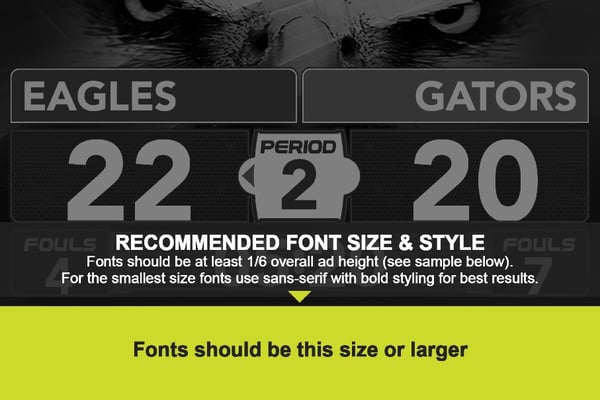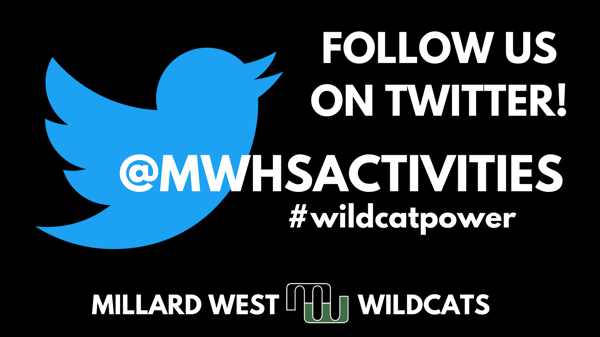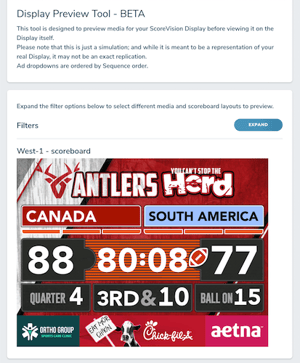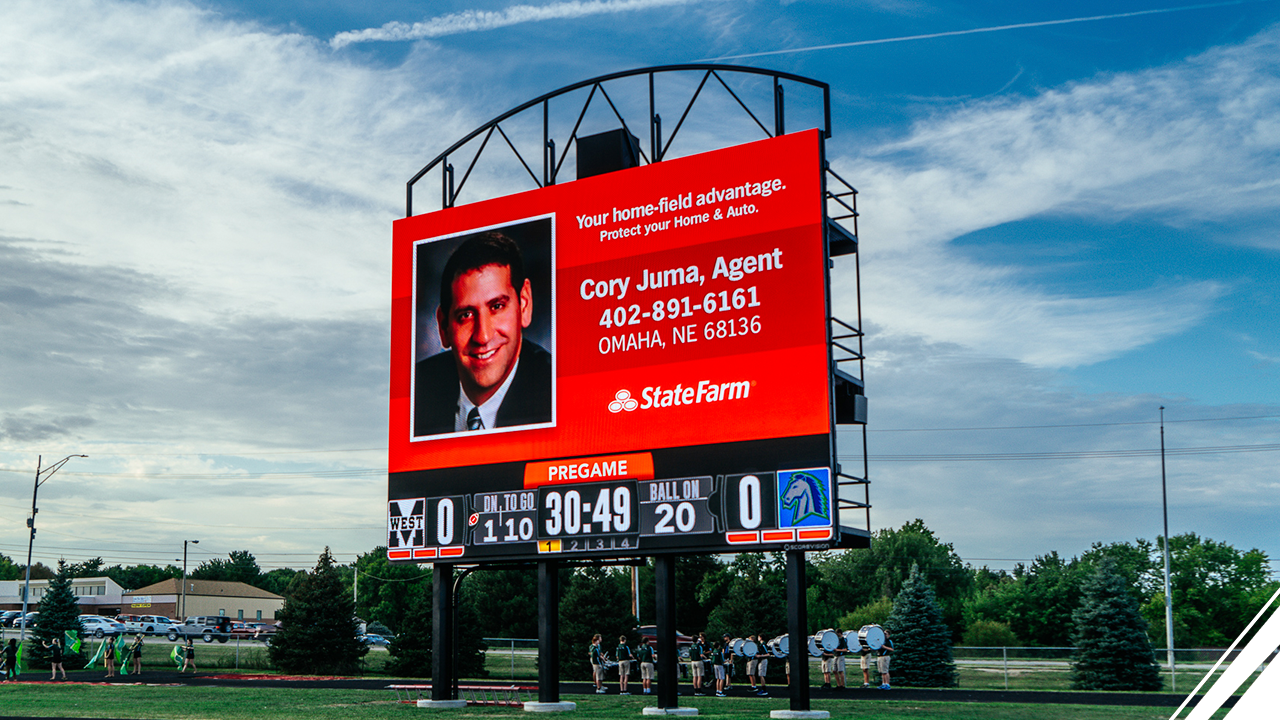As LED video scoreboards grow in popularity, the need to develop creative yet effective designs is becoming more important. But if you're stumped on how to make engaging graphics for your LED video board, you're not alone.
LED video scoreboards are a unique medium with its own set of best practices. These best practices combine a unique mix of graphic design principles for advertising and billboards with the science behind LED technology. Before you create your next graphics for your LED multimedia scoreboard, check out these 7 tips to making awesome, engaging, and effective graphics for LED displays.
1. Keep it Simple
Think of billboards that you pass on your way to school or work. Billboards have only a few seconds to get their message across to drivers, so the most effective billboards keep their message very simple and straightforward.
The same thought process applies to LED video scoreboards. Fans may only look up at the video scoreboard for a few seconds at a time when they check the score throughout intense sporting events, so advertisements and other announcements may only get this short period of time to get their message across. So keep it short and sweet – simplify your message and pick only one thing you want your audience to do or recognize.
Start by determining the purpose of the graphic and the message it should convey. Then, simplify that message to the absolute essentials. We recommend using no more than ten words total on the entire graphic, including any logos or taglines. You should also avoid long or complex words. A short and simple message made of short and simple words will give your graphic the best chance at being understood by fans.
You should also consider the distance at which fans will be seated away from the video display. In most gyms and stadiums, fans are seated at least 50 feet or more away from the board. For this reason, it's even more important to keep your message simple, clear, and easy to read.


2. Use Large Text
As the distance increases between fans and the video board, thin lines and fine details tend to fade or break up due to the pixels of an LED display. In order to make sure your message stays clear from across the gym or stadium, follow these guidelines:
- Always use large, legible, sans-serif typefaces.
- Avoid decorative, italic, or serif fonts.
- Keep important text toward the center of the graphic.
- Consider making the text bold if the font size will be small; the larger the text, the less bold the characters need to be.
- The minimum text height on the display should be 3", which is about 1/6 the height of a Panorama Ad on a ScoreVision indoor video scoreboard.

3. Avoid White Backgrounds
This recommendation is where the science of LED comes into play. To achieve white on an LED display, a combination of all three red, blue, and green bulbs must be turned on to their maximum brightness. Because of this, using a white background on your graphics will wash out and compete with the remainder of what is on the graphic.
In order to create the effect of a white background but without this consequence, it is best to instead use any alternative to true white, which includes off-white, light gray, cream, or any pastel-colored background. However, for the best readability, consider avoiding very light backgrounds altogether and opt for a dark or black background if your design idea allows.
.png?width=600&name=We_Are_Millard_West_(1).png)
4. Use Bold Colors
The key to any great design, including design for LED displays, is using colors that contrast. Being subtle does not work well for many types of design, especially those that are viewed at a distance (such as video scoreboards). Stick with fully saturated, web-safe hues. Contrasting color combinations work best at far distances, while complimentary colors (such as red and green) become very difficult to see together because they have similar value. Some color combinations that would be most effective on LED video boards include:
- Black with white or yellow
- Blue with white or yellow
- Green and white
In addition to choosing bold colors, we recommend avoiding design elements such as gradients, shadows, and subtle or busy textures as the pixels of an LED board can make these appear grainy or pixellated at closer distances.

5. Choose Images Wisely
If your graphic involves a logo, image, or combination of both, be sure to choose images that are simple and high-quality. You should limit the textures and fine details of your photos, logos, and other design elements as those details will likely not show up as well on an LED video scoreboard. As a rule of thumb, it is more effective to enlarge small objects than to shrink large objects to fit within your space. You should also avoid using landscapes or other complex scenes in your graphic.
We recommend using three visual elements or less, total. For example, your graphic could be built from one image, one logo, and one headline.

6. Build the Right File Type
As you build your graphics, be sure to use the correct dimensions and specifications for your LED display. The most commonly accepted file formats are JPG and PNG, which are the file types necessary if you are uploading these graphics to a ScoreVision system.
7. Test Your Ideas Before Game-time
 Whenever possible, test your graphics before the actual game or event so you have enough time to make changes if needed. It's always best to preview your design on the actual LED display where it will play, but if you aren't able to get to the gym or stadium to preview it, you may have other options. ScoreVision customers enjoy a Display Preview Tool built right into their ScoreVision Cloud accounts, where you can upload your brand wrappers and automated graphics to the cloud and preview it on a mockup of your display in various sports and scoreboard layouts.
Whenever possible, test your graphics before the actual game or event so you have enough time to make changes if needed. It's always best to preview your design on the actual LED display where it will play, but if you aren't able to get to the gym or stadium to preview it, you may have other options. ScoreVision customers enjoy a Display Preview Tool built right into their ScoreVision Cloud accounts, where you can upload your brand wrappers and automated graphics to the cloud and preview it on a mockup of your display in various sports and scoreboard layouts.
Are you looking to bring a video scoreboard into your gym or stadium? Contact us today using the form below!
Request More Information
Request more information below to learn more about bringing a ScoreVision system to your school or facility.










